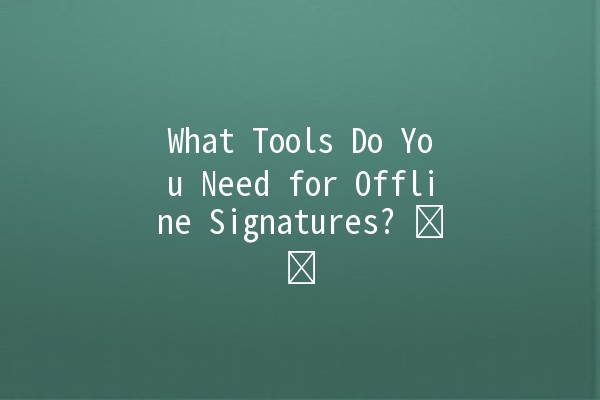
In an increasingly digital world, the need for offline signatures still holds considerable importance. Whether for formal agreements, contracts, or other essential documents, knowing the right tools for offline signatures can significantly enhance your productivity and ensure proper document management. Below, we explore various tools that can help you effectively manage offline signatures while also covering five productivityboosting tips to streamline the process.
Understanding Offline Signatures
An offline signature is a handwritten mark or signature made on physical documents, as opposed to digital or electronic signatures. While digital signatures have gained popularity in recent years, offline signatures are still needed in several scenarios, such as legal documents, real estate transactions, and any agreements that require a personal touch.
Having the right tools for capturing offline signatures can enhance efficiency, ensuring you can manage important documents effortlessly. Here are some tools and techniques to consider:
Essential Tools for Offline Signatures
Overview: A good pen is fundamental to producing clear and legible signatures. Choose pens with fluid ink and comfortable grip to ensure you can sign with ease.

Example: etip gel pens or fountain pens can provide a smooth writing experience and produce ink that dries quickly, preventing smudging.
Overview: Signature pads are specialized devices designed to capture handwritten signatures electronically. Alternatively, using highquality signature papers can provide a tactile experience while also ensuring that your signature appears professional.
Example: Opt for signature pads that come with USB or Bluetooth connection options. For paper, choose acidfree paper that resists fading over time.
Overview: A portable scanner is invaluable for converting signed documents into digital formats. This tool allows you to archive important agreements and contracts while preserving the original signed version.
Example: Compact options like the Fujitsu ScanSnap or Doxie Go can scan documents directly to your computer or cloud storage via WiFi.
Overview: When signing multiple documents or during meetings, a sturdy clipboard or folder aids organization and makes the signing process smooth.
Example: Choose a clipboard with a builtin storage compartment for keeping essential documents together, or opt for an expanding folder that categorizes documents by type.
Overview: Although primarily supporting digital documents, document management software can integrate offline and online signature processes to create a seamless workflow.
Example: Programs like DocuWare and Adobe Acrobat allow you to store, share, and manage signed documents effectively. You can also integrate signing protocols to ease the transition from physical to digital.
Productivity Enhancement Tips
Here are five productive strategies to improve the offline signature process:
Tip 1: Create a Signature Routine ⏰
Explanation: Establish a specific time and place dedicated to managing signatures. This could be at the end of your workday or during a quiet hour when tasks are somewhat manageable.
Example: Mark every Friday at 3 PM as “Signature Hour,” where you gather documents and complete all signing tasks in one go. This concentrated effort reduces distractions and increases efficiency.
Tip 2: Use Presigned Templates 🖊️
Explanation: For documents that regularly require signatures, presigned templates can expedite the process by eliminating the need to sign every single time.
Example: If you frequently issue contracts for similar services, have a template prepared with your signature, allowing you to add your electronic signature alongside current date details.
Tip 3: Organize Your Documents 📁
Explanation: Keeping your documents organized is vital for quickly locating what you need when it’s time to sign.
Example: Implement a clear labeling system for signed documents, whether physical or digital. Consider colorcoding or creating categories to find what you need faster.
Tip 4: Minimize Interruptions 🚫🔊
Explanation: To maintain focus on document management, limit outside distractions.
Example: Inform colleagues not to disturb you during signature time or use “Do Not Disturb” signs in your workspace, allowing for uninterrupted focus.
Tip 5: Delegate When Necessary ✔️
Explanation: If managing signatures becomes overwhelming, delegate or assign this task to an assistant or a team member.
Example: Create a system where someone else handles routine signing tasks, while you focus on more complex documents requiring your personal attention.
Frequently Asked Questions
Offline signatures are crucial for authenticity and legal compliance in many traditional industries, ensuring that agreements bear the personal verification of stakeholders.
While any pen can technically be used, it is advisable to use highquality pens that provide consistent ink flow and good writing experience to ensure clear and legible signatures.
Legal requirements can vary by jurisdiction. Generally, a handwritten signature is considered necessary for most contracts, but always check local regulations.
Store signed documents in a secure location, such as a locked filing cabinet for physical copies or encrypted digital storage for scanned documents to ensure confidentiality.
A wellstructured document management system helps maintain organization. Use categorized folders, either physical or digital, to keep track of which documents need signatures and which have been completed.
Yes, you can utilize digital tools to complement offline signature processes, digitizing documents via scanning after signing to facilitate sharing and recordkeeping.
The tools and tips discussed above are designed to simplify the process of managing offline signatures. From the right writing instruments to effective organization strategies, implementing these techniques can boost your productivity and ensure your signature process is efficient and professional. Understanding the tools and methods at your disposal creates a balance between necessary tasks and a streamlined workflow, paving the way for smoother business operations.

